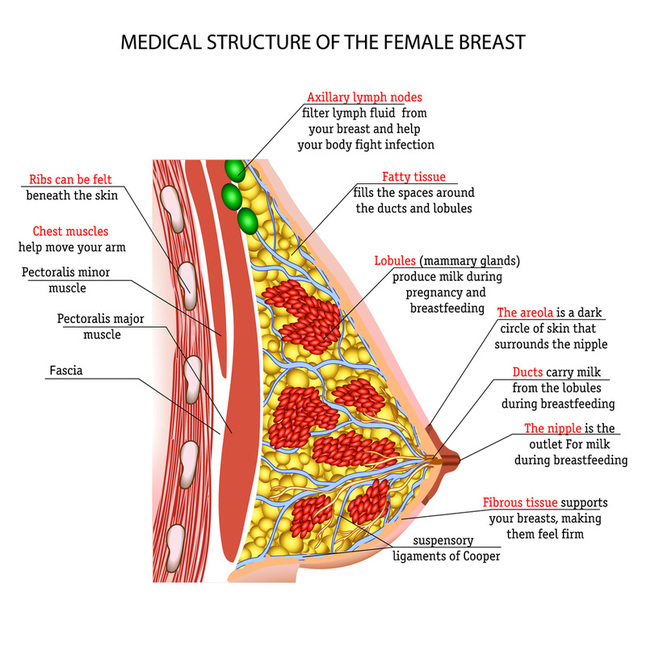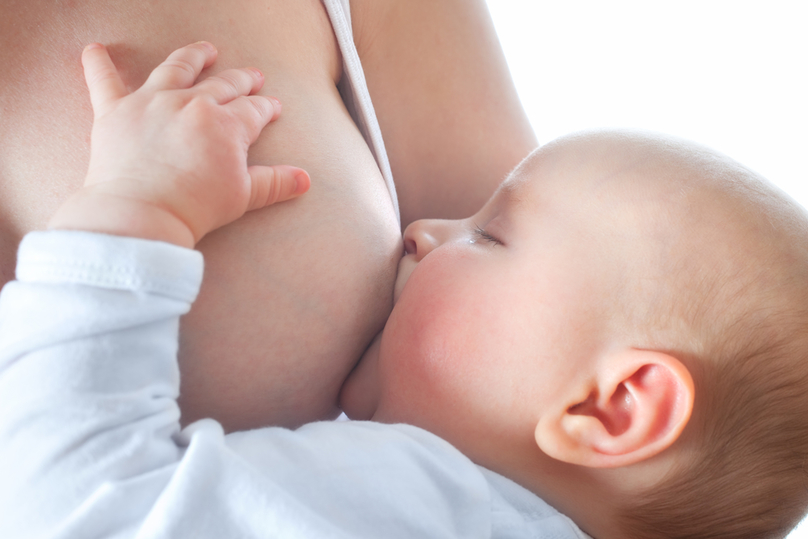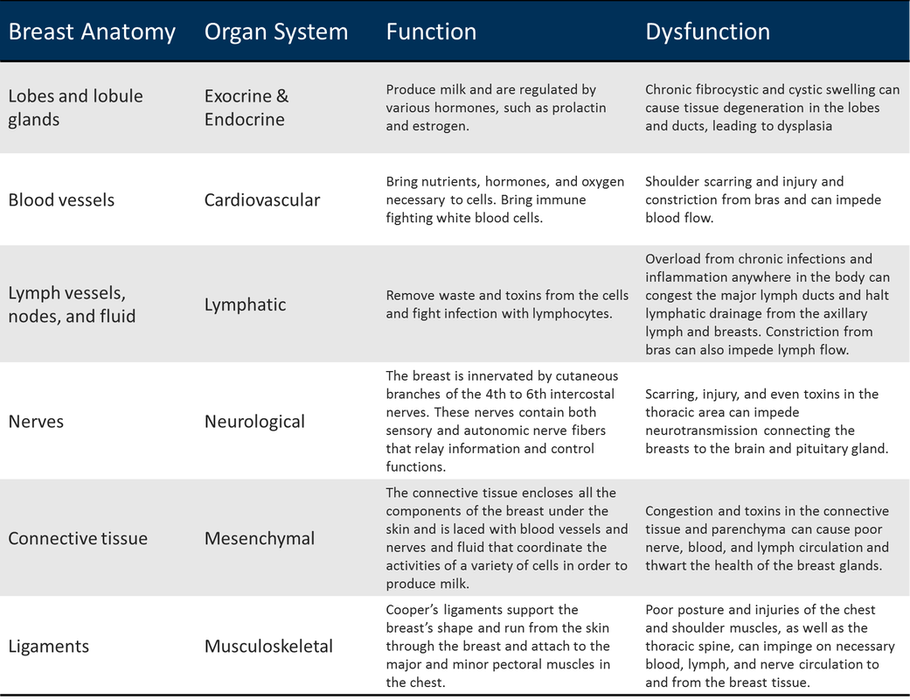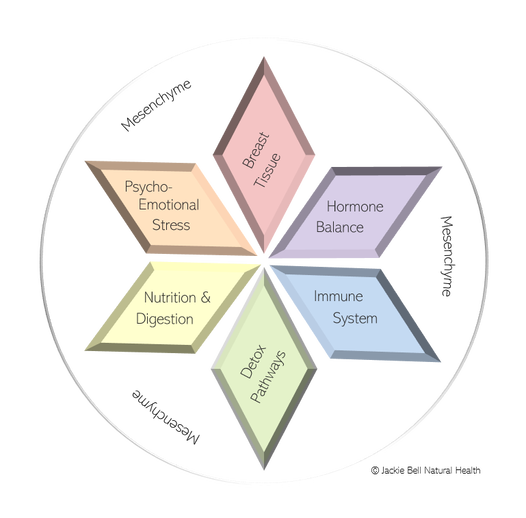BREAST TISSUE
In a holistic approach to breast health, of course the organ of concern is evaluated and treated, but always in context of (and with respect for) the rest of the person too. Here is a brief, bird's-eye view of the breasts and their interrelations.
Structure and Function - Anatomy & Physiology 101
Anatomically, the breasts are called exocrine glands; they secrete substances externally rather than into the bloodstream. Biologically, a woman’s breasts play a major role in procreation by
- stimulating sexual desire,
- producing milk to nourish a newborn baby, and
- passing on antibodies needed for the newborn’s immunity.
Fatty Tissue
The fatty tissue takes up most of the breast anatomy. It’s called adipose tissue, and it also surrounds all our major organs providing them with energy, insulation, protection, and unfortunately storage for toxins too.
The fatty tissue is embedded within a network of ligaments, fibrous connective tissue, nerves, lymph vessels and nodes, and blood vessels. Each of these parts plays a role in keeping the breast healthy, as do the organ systems they belong to. Any chronic imbalances and dysfunction within these corresponding systems can weaken the health of the breasts.
Breast Tissue - Lobes of Lobules
The mammary gland or breast tissue is the network of lobules and ducts surrounded by the fatty and fibrous connective tissues. Lobules are minuscule glands that produce milk. Clusters of alveoli make up lobules, clusters of lobules make up the lobes, and there are 12-20 lobes in each breast (every woman is different).
As a basic illustration, if the lobules were grapes, each lobe would be similar to a bunch of grapes. From each tiny lobule, the milk flows into a tiny duct, and then into a network of ducts that join together like branches of grape stems into increasingly larger ducts. There are about 10 ductal systems in each breast, each with a primary opening at the nipple for secretion.
Physiologically, during the menstrual cycle the glandular and connective tissues tend to swell due to cyclical changes in the levels of estrogen and progesterone. The lobules and ducts enlarge, and in turn, the breasts retain water, which is why the breasts can feel swollen, tender, or even lumpy before and during menses. Because the condition is hormone-related, it will usually affect both breasts at the same time.
As a woman approaches menopause, the tissues of the ductile system become fibrous and degenerate causing the breast lobes, having been kept firm for milk production, to involute and shrink and lose the ability to produce milk. The lobes are replaced with fatty tissue, thus making the breasts even more susceptible to toxin storage after menopause.
After menopause, the time when menstruation stops and estrogen levels are much lower, uncomfortable hormone-related symptoms normally subside but can be persistent if a woman takes hormone replacement therapy.
As a woman approaches menopause, the tissues of the ductile system become fibrous and degenerate causing the breast lobes, having been kept firm for milk production, to involute and shrink and lose the ability to produce milk. The lobes are replaced with fatty tissue, thus making the breasts even more susceptible to toxin storage after menopause.
After menopause, the time when menstruation stops and estrogen levels are much lower, uncomfortable hormone-related symptoms normally subside but can be persistent if a woman takes hormone replacement therapy.
Women with fibrocystic breasts commonly experience cysts (closed pods of accumulated fluid), lumpiness, bilateral tenderness or pain and are usually diagnosed with dense breast tissue. Since breast and connective tissue are denser than fatty tissue, dense breast tissue means that there is a greater amount of breast and connective tissue compared to fat. The amount of lobular tissue in the breast depends on hormonal activity, especially the body's balance of estrogen.
Areola & Nipple
The nipple is surrounded by a circular area of pink or brown skin, called the areola, which contains small sweat glands designed to secrete moisture as a soothing lubricant during breast-feeding. The areola is the termination area for the fourth intercostal nerve, which transmits sensory information about any stimulation to the spinal cord and the brain during breast-feeding and sexual play.
The process of milk secretion is regulated by nerve impulses from sympathetic and parasympathetic components of the autonomic nervous system, as well as by certain hormones.
The nipple is considered a secondary excretion pathway for the body and can discharge mucous and pus if there is an infection in the breast tissue when a woman is not lactating. A sign of breast tissue degeneration is when the nipple becomes inverted and fluids can no longer be excreted, furthering the cultivation of any disease process that can overrun the breast tissue.
Organ Systems Related to the Breasts
This chart gives an overview of the organ systems related to the breasts and the significance of their function to the health and vibrancy of the breast tissue.
Holistic Breast Care
It's essential that an annual breast analysis encompasses more than a physical exam or x-ray of the anatomical structure of the breast because recognition of a symptom, such as a lump or density, will happen only after a disease process is well-established in the physiology.
To stay ahead in the game, it would be helpful to review the Breast Anatomy-Organ System chart and make a mental checklist of what might be influencing the nerve, blood, and lymphatic circulation to your breasts so that you can do something about it sooner than later. For example, if you have neck and shoulder tension, breast scars, shoulder injuries, love for your sexy push-up bras, or chronic allergies, a skilled massage therapist can come to your rescue throughout the year and keep your circulation optimized.
It's what you do for yourself everyday and regularly that matters the most in (breast) health.
The 6 Facets
Understanding the working parts of the breast is the gateway to understanding how they are affected by associated organ systems as outlined in the rest of the 6 Facets.
6 FACETS OF BREAST HEALTH
Got lumpy tender breasts?
Most women notice blessed relief within 2 weeks of doing a daily self-breast massage.
BRUSH AND FLOSS YOUR BREASTS







